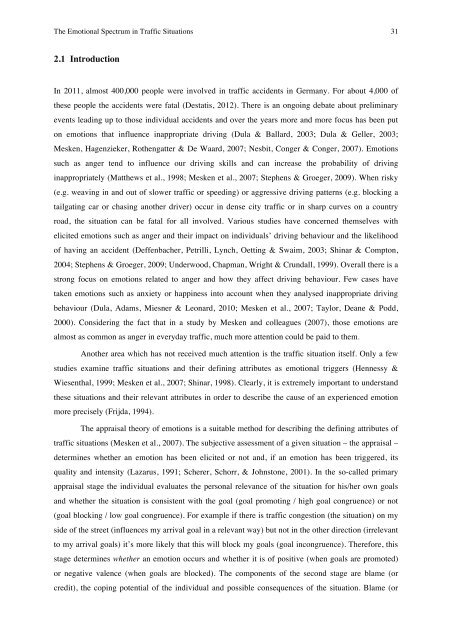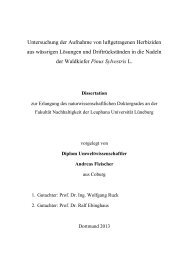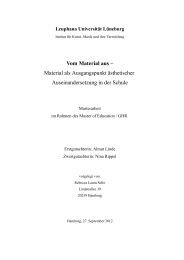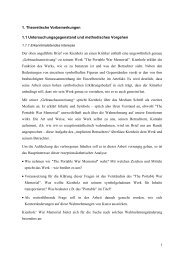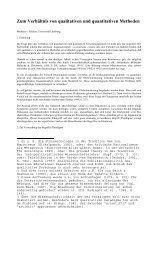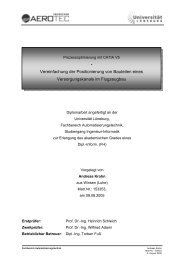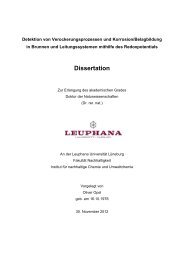Determinants of Emotional Experiences in Traffic Situations ... - OPUS
Determinants of Emotional Experiences in Traffic Situations ... - OPUS
Determinants of Emotional Experiences in Traffic Situations ... - OPUS
Create successful ePaper yourself
Turn your PDF publications into a flip-book with our unique Google optimized e-Paper software.
The <strong>Emotional</strong> Spectrum <strong>in</strong> <strong>Traffic</strong> <strong>Situations</strong> 31<br />
2.1 Introduction<br />
In 2011, almost 400,000 people were <strong>in</strong>volved <strong>in</strong> traffic accidents <strong>in</strong> Germany. For about 4,000 <strong>of</strong><br />
these people the accidents were fatal (Destatis, 2012). There is an ongo<strong>in</strong>g debate about prelim<strong>in</strong>ary<br />
events lead<strong>in</strong>g up to those <strong>in</strong>dividual accidents and over the years more and more focus has been put<br />
on emotions that <strong>in</strong>fluence <strong>in</strong>appropriate driv<strong>in</strong>g (Dula & Ballard, 2003; Dula & Geller, 2003;<br />
Mesken, Hagenzieker, Rothengatter & De Waard, 2007; Nesbit, Conger & Conger, 2007). Emotions<br />
such as anger tend to <strong>in</strong>fluence our driv<strong>in</strong>g skills and can <strong>in</strong>crease the probability <strong>of</strong> driv<strong>in</strong>g<br />
<strong>in</strong>appropriately (Matthews et al., 1998; Mesken et al., 2007; Stephens & Groeger, 2009). When risky<br />
(e.g. weav<strong>in</strong>g <strong>in</strong> and out <strong>of</strong> slower traffic or speed<strong>in</strong>g) or aggressive driv<strong>in</strong>g patterns (e.g. block<strong>in</strong>g a<br />
tailgat<strong>in</strong>g car or chas<strong>in</strong>g another driver) occur <strong>in</strong> dense city traffic or <strong>in</strong> sharp curves on a country<br />
road, the situation can be fatal for all <strong>in</strong>volved. Various studies have concerned themselves with<br />
elicited emotions such as anger and their impact on <strong>in</strong>dividuals’ driv<strong>in</strong>g behaviour and the likelihood<br />
<strong>of</strong> hav<strong>in</strong>g an accident (Deffenbacher, Petrilli, Lynch, Oett<strong>in</strong>g & Swaim, 2003; Sh<strong>in</strong>ar & Compton,<br />
2004; Stephens & Groeger, 2009; Underwood, Chapman, Wright & Crundall, 1999). Overall there is a<br />
strong focus on emotions related to anger and how they affect driv<strong>in</strong>g behaviour. Few cases have<br />
taken emotions such as anxiety or happ<strong>in</strong>ess <strong>in</strong>to account when they analysed <strong>in</strong>appropriate driv<strong>in</strong>g<br />
behaviour (Dula, Adams, Miesner & Leonard, 2010; Mesken et al., 2007; Taylor, Deane & Podd,<br />
2000). Consider<strong>in</strong>g the fact that <strong>in</strong> a study by Mesken and colleagues (2007), those emotions are<br />
almost as common as anger <strong>in</strong> everyday traffic, much more attention could be paid to them.<br />
Another area which has not received much attention is the traffic situation itself. Only a few<br />
studies exam<strong>in</strong>e traffic situations and their def<strong>in</strong><strong>in</strong>g attributes as emotional triggers (Hennessy &<br />
Wiesenthal, 1999; Mesken et al., 2007; Sh<strong>in</strong>ar, 1998). Clearly, it is extremely important to understand<br />
these situations and their relevant attributes <strong>in</strong> order to describe the cause <strong>of</strong> an experienced emotion<br />
more precisely (Frijda, 1994).<br />
The appraisal theory <strong>of</strong> emotions is a suitable method for describ<strong>in</strong>g the def<strong>in</strong><strong>in</strong>g attributes <strong>of</strong><br />
traffic situations (Mesken et al., 2007). The subjective assessment <strong>of</strong> a given situation – the appraisal –<br />
determ<strong>in</strong>es whether an emotion has been elicited or not and, if an emotion has been triggered, its<br />
quality and <strong>in</strong>tensity (Lazarus, 1991; Scherer, Schorr, & Johnstone, 2001). In the so-called primary<br />
appraisal stage the <strong>in</strong>dividual evaluates the personal relevance <strong>of</strong> the situation for his/her own goals<br />
and whether the situation is consistent with the goal (goal promot<strong>in</strong>g / high goal congruence) or not<br />
(goal block<strong>in</strong>g / low goal congruence). For example if there is traffic congestion (the situation) on my<br />
side <strong>of</strong> the street (<strong>in</strong>fluences my arrival goal <strong>in</strong> a relevant way) but not <strong>in</strong> the other direction (irrelevant<br />
to my arrival goals) it’s more likely that this will block my goals (goal <strong>in</strong>congruence). Therefore, this<br />
stage determ<strong>in</strong>es whether an emotion occurs and whether it is <strong>of</strong> positive (when goals are promoted)<br />
or negative valence (when goals are blocked). The components <strong>of</strong> the second stage are blame (or<br />
credit), the cop<strong>in</strong>g potential <strong>of</strong> the <strong>in</strong>dividual and possible consequences <strong>of</strong> the situation. Blame (or<br />
!


